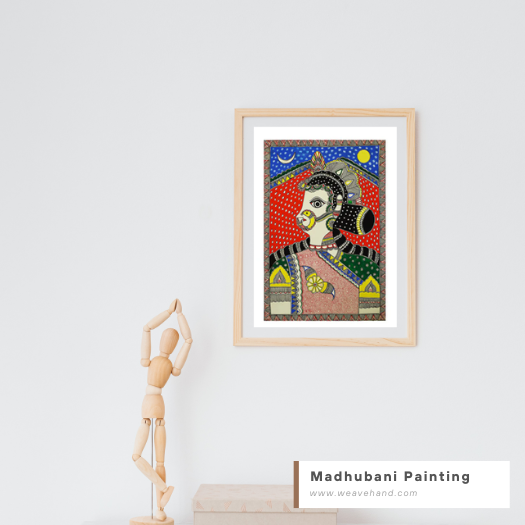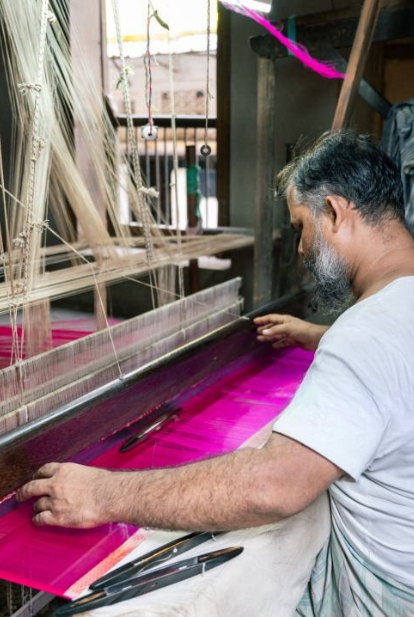
Introduction: The Timeless Canvas of Mithila
Mithila Painting, also known as Madhubani Art, is one of India’s most celebrated folk art traditions. Originating from the Mithila region of Bihar, this vibrant art form is more than just decorative—it is a cultural expression, a storytelling medium, and a heritage passed down through generations. Today, Mithila paintings are not just confined to mud walls and courtyards but have found their way onto canvases, textiles, home décor, and even global art exhibitions.
At Weavehand, we celebrate this ancient craft by connecting artisans to modern markets, giving you authentic pieces that carry both tradition and elegance.
The Origins of Mithila Painting
The roots of Mithila Painting trace back to the time of the epic Ramayana. Legend has it that when King Janaka of Mithila organized the marriage of his daughter Sita to Lord Rama, he asked the women of the kingdom to decorate the walls with paintings. Since then, the art became a part of every celebration, festival, and ritual in the region.
Traditionally, Mithila art was painted on mud walls with natural colors derived from plants, flowers, turmeric, and soot. With time, the art shifted to handmade paper, fabric, and canvas, but the essence remained the same.
The Unique Styles and Themes of Mithila Art
Mithila paintings are easily recognizable by their bold outlines, vibrant colors, and intricate patterns. Each piece tells a story, often inspired by mythology, nature, and daily life.
Popular Themes in Mithila Painting:
-
Mythological Tales: Stories of Rama-Sita, Krishna-Radha, and Shiv-Parvati.
-
Nature & Fertility Symbols: Fish, peacocks, lotus, and trees representing prosperity and love.
-
Festivals & Rituals: Traditional ceremonies, weddings, and folk traditions.
-
Abstract Expressions: Modern-day themes merged with traditional motifs.
Styles of Mithila Painting:
-
Kachni – Line-based, monochrome drawings filled with fine patterns.
-
Bharni – Brightly colored artworks with vibrant infill.
-
Godna – Inspired by tribal tattoo patterns.
-
Tantrik – Depicting religious and spiritual themes.
The Role of Women in Preserving Mithila Art
One of the most beautiful aspects of Mithila painting is its deep connection with women. For centuries, it has been a household tradition, passed on from mothers to daughters. Women were the primary creators, painting walls to mark weddings, festivals, and significant rituals.
Even today, women artisans of Bihar continue to preserve and evolve this art, making it a source of livelihood, empowerment, and cultural pride.
Sustainability and Modern Adaptation
Mithila painting is not only culturally rich but also sustainable. Traditionally, natural dyes and handmade paper are used, reducing environmental impact. Modern artisans are blending traditional motifs with contemporary designs, making the art relevant in today’s fashion and décor world.
At Weavehand, we bring you Mithila art in the form of wall hangings, sarees, stoles, home décor, and accessories—ensuring that you own not just a product, but a story.
Why Choose Authentic Mithila Art?
-
Supports local artisans and women’s empowerment.
-
Keeps alive an ancient Indian tradition.
-
Perfect blend of art, culture, and sustainability.
-
Adds vibrance and uniqueness to your lifestyle.
Conclusion: A Living Tradition of Colors and Stories
Mithila painting is not just art—it is a language of colors, a symbol of heritage, and a bridge between the past and present. Owning a piece of Mithila art means carrying forward centuries of tradition while supporting the artisans who dedicate their lives to this craft.
At Weavehand, we are proud to bring you authentic hand-painted products that carry blessings, stories, and timeless beauty.
FAQs on Mithila Painting
Q1: What is the difference between Mithila Painting and Madhubani Painting?
They are the same. Mithila painting is the broader term for the art from Mithila, while Madhubani is the district in Bihar where it gained worldwide recognition.
Q2: Are natural colors still used in Mithila paintings?
Yes, many artisans continue to use natural colors from flowers, leaves, and minerals, though synthetic colors are also used today for durability.
Q3: Can Mithila art be customized for home décor or fashion?
Absolutely! From sarees and dupattas to coasters and wall panels, Mithila art adapts beautifully to modern design needs.
Q4: How does buying Mithila art help artisans?
Every purchase supports rural artisans, especially women, by giving them fair wages and recognition for their craft.
Q5: Where can I buy authentic Mithila painting products?
You can explore Weavehand.com for authentic, handcrafted Mithila art products directly sourced from artisans.



